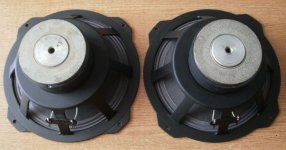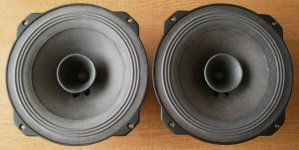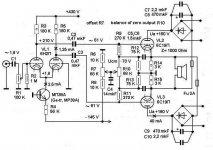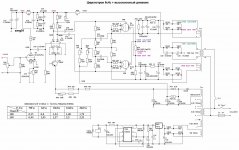Self-designed full-range speaker with a high resistance. Especially for transformerless tube amplifiers. Rated impedance 1000 ohms. However, he has a very weak dependence on the frequency of resistance at medium and high frequencies. Provisional title 10GDSH-1-1000.
Diameter of 8 inches
Diameter of 8 inches
Attachments
Last edited:
Nice job; first units of this type I've seen since the old Philips 800ohm drivers from the 1950s - '60s.
Thank you!
In his designs try to get rid of reactive elements as possible. In this case, despite the multi-layer coil was reduced reactive parameter - inductance.
In his designs try to get rid of reactive elements as possible. In this case, despite the multi-layer coil was reduced reactive parameter - inductance.
Last edited:
Very impressive. Congratulations to Your fine work.
I have a Philips amplifier for 800 ohm speakers and have puzzled with the idea of rolling voicecoils for existing low-impedance units.
You are rolling voicecoils Yourself?
I am interested in hearing Your experiences with this work. And the challenges.
I have a Philips amplifier for 800 ohm speakers and have puzzled with the idea of rolling voicecoils for existing low-impedance units.
You are rolling voicecoils Yourself?
I am interested in hearing Your experiences with this work. And the challenges.
Voice coils are made to order, using special equipment, according to my drawings.
If You notice, these speakers have very low inductance. It is much lower than that of their counterparts of low resistance.
Do You have a Philips 800 ohm speakers?
You could not measure their Z, Phillips 800 ohms at a frequency up to 200 kHz?
It is very necessary for comparison.
Here's what's interesting. Sound from low-inductance full-range speakers to a "normal" 8 ohms is very different from the sound of the same full-range speaker, but with a "normal" inductance.
Inductance frequency dependent.
Therefore it was necessary to introduce the term "doubling the minimum impedance " F2z.
Typically F2z=7-15 kHz for full-range speakers.
The same was observed with high-resistance full-range speakers.
It would be ideal if F2z exceeded the sound range.
As is the case in high-frequency speakers. Better if twice F2z = 31-40 kHz.
If You notice, these speakers have very low inductance. It is much lower than that of their counterparts of low resistance.
Do You have a Philips 800 ohm speakers?
You could not measure their Z, Phillips 800 ohms at a frequency up to 200 kHz?
It is very necessary for comparison.
Here's what's interesting. Sound from low-inductance full-range speakers to a "normal" 8 ohms is very different from the sound of the same full-range speaker, but with a "normal" inductance.
Inductance frequency dependent.
Therefore it was necessary to introduce the term "doubling the minimum impedance " F2z.
Typically F2z=7-15 kHz for full-range speakers.
The same was observed with high-resistance full-range speakers.
It would be ideal if F2z exceeded the sound range.
As is the case in high-frequency speakers. Better if twice F2z = 31-40 kHz.
Last edited:
Hi,
FWIW AFAIK you could never sell commercially any speakers
of ~ 1Kohm and any amplifier that is capable of driving them.
The standards just don't exist for high voltage speaker drive,
and though no expert, I'm sure you'll fall foul of the allowed
standards for whatever speaker connection method you use.
rgds, sreten.
FWIW AFAIK you could never sell commercially any speakers
of ~ 1Kohm and any amplifier that is capable of driving them.
The standards just don't exist for high voltage speaker drive,
and though no expert, I'm sure you'll fall foul of the allowed
standards for whatever speaker connection method you use.
rgds, sreten.
Phillips was the standard of 800 ohms?
So why not be the 2000 ohms?
...............................................................
Such systems are already working in Ukraine, more than a year.
The first of these resistance of 1 000 ohm. Two-way.
Two months operates two full-range speakers impedance 2000 ohms.
.......................................
I am an engineer. Itself can develop the standard. In the extreme case)))
Especially if there's a good theory, and not just one hammer for its implementation. )))
So why not be the 2000 ohms?
...............................................................
Such systems are already working in Ukraine, more than a year.
The first of these resistance of 1 000 ohm. Two-way.
Two months operates two full-range speakers impedance 2000 ohms.
.......................................
I am an engineer. Itself can develop the standard. In the extreme case)))
Especially if there's a good theory, and not just one hammer for its implementation. )))
Last edited:
Hi,
You can't develop the "standard". It will always
be illegal in terms of consumer products to sell
an amplifier that can drive your speaker units,
with any form of current speaker connection.
Stupid but true AFAIK.
rgds, sreten.
I don't know what the actual voltage limits are.
You can't develop the "standard". It will always
be illegal in terms of consumer products to sell
an amplifier that can drive your speaker units,
with any form of current speaker connection.
Stupid but true AFAIK.
rgds, sreten.
I don't know what the actual voltage limits are.
Last edited:
Svjatoslav, I am also engeneer and work a lot with foreign standards.
I think you did not catch what Sreten wrote. He mean that thera are some certain legal limitations for all aconsumer products, and whatever own technical standard you would develop - it will be not allowed to be out of regulatory limits. In wesetrn world its very clear and much more respected by even consumers/users not only by designers than in CIS.
I think you did not catch what Sreten wrote. He mean that thera are some certain legal limitations for all aconsumer products, and whatever own technical standard you would develop - it will be not allowed to be out of regulatory limits. In wesetrn world its very clear and much more respected by even consumers/users not only by designers than in CIS.
sreten, Charcoal, as far as I know, this nonsense does not apply to kits for the construction.
For full-range speaker, impedance 2000 ohms, maximum peak value of the AC voltage 230 V, 110 mA peak current.
Peak power 13 W.
For full-range speaker, impedance 2000 ohms, maximum peak value of the AC voltage 230 V, 110 mA peak current.
Peak power 13 W.
Last edited:
Probably be you are right, I did not research these particular standards in details.
Could you show measered nearfield frequency response? Very interesting to see, especially how the highs are stretched.
Could you show measered nearfield frequency response? Very interesting to see, especially how the highs are stretched.
Are you worried that there are loss of at high frequencies?
Plan to conduct an accurate test in an anechoic chamber. Auditory monitoring shows unusually accurate transmission front musically. Uncharacteristic for full range speakers.
Attribute this to a sharp decline in the inductive component of the resistance (Z).
Plan to conduct an accurate test in an anechoic chamber. Auditory monitoring shows unusually accurate transmission front musically. Uncharacteristic for full range speakers.
Attribute this to a sharp decline in the inductive component of the resistance (Z).
I know this difference of low indusctance when compare to voice coils with round and flat wire.
But I never listend to high impedance speakers with many layers of wire, so its intrigue me, if its really possibl eto get that result with multy layer coil.
But I never listend to high impedance speakers with many layers of wire, so its intrigue me, if its really possibl eto get that result with multy layer coil.
A plot of the impedance on the frequency speaks for itself.
This precise measurements.
..............................
The same effect of increasing the accuracy of transmission signal edge occurs at low inductance version of this broadband speaker impedance of 8 ohms.
This precise measurements.
..............................
The same effect of increasing the accuracy of transmission signal edge occurs at low inductance version of this broadband speaker impedance of 8 ohms.
I'd guess that some of the larger Neutrik speakOn connectors would probably hack it.
Here we go - dielectric strength of 4kV, rated voltage 250v (guessing RMS, so ~320v peak, 640v p/p).
Into that speaker, the 250v rating is good for ~63w, which would probably burn the coil, so I don't think there'll be much problem with the connector giving up first.
Chris
Here we go - dielectric strength of 4kV, rated voltage 250v (guessing RMS, so ~320v peak, 640v p/p).
Into that speaker, the 250v rating is good for ~63w, which would probably burn the coil, so I don't think there'll be much problem with the connector giving up first.
Chris
Hi,
You can't develop the "standard". It will always
be illegal in terms of consumer products to sell
an amplifier that can drive your speaker units,
with any form of current speaker connection.
Stupid but true AFAIK.
rgds, sreten.
I don't know what the actual voltage limits are.
For safety reasons, and to avoid someone getting the Darwin award, I think it is quite acceptable of this amp/speaker pair to require proprietary connections.
Typical professional amplifier 800 W / 8 ohm output is more than 113 volts.
Closed Speakon connectors and appropriate professional cable will solve the issue of electrical safety.
Two free contact pairs Speakon four maybe used for the relay. In the amplifier circuit relay commutes anode supply.
Which switch anode amplifier supply in the case of connect to the off speaker.
Closed Speakon connectors and appropriate professional cable will solve the issue of electrical safety.
Two free contact pairs Speakon four maybe used for the relay. In the amplifier circuit relay commutes anode supply.
Which switch anode amplifier supply in the case of connect to the off speaker.
I do own a pair of Philips 3800 AM and 3700 AM both pairs rated 800 Ohm impedance.
Am sorry, but I don't have equipment to make a measurement as proposed.
As for the standard, I have been told that approval for sale of the Philips amplifiers was difficult due to high voltages in speaker-cords. If a cat bit the cord, it could easily pay the ultimate price.
For 2000 Ohms, voltages will be even higher to drive the speakers, so maybe there is a commercial restance-range, that is applicable?
Am hoping to hear more about this great initiative, allthough the Qts is pretty high and is maybe best with a sealed box enclosure?
Thank You for answering. Much appreciated!
Am sorry, but I don't have equipment to make a measurement as proposed.
As for the standard, I have been told that approval for sale of the Philips amplifiers was difficult due to high voltages in speaker-cords. If a cat bit the cord, it could easily pay the ultimate price.
For 2000 Ohms, voltages will be even higher to drive the speakers, so maybe there is a commercial restance-range, that is applicable?
Am hoping to hear more about this great initiative, allthough the Qts is pretty high and is maybe best with a sealed box enclosure?
Thank You for answering. Much appreciated!
- Status
- Not open for further replies.
- Home
- Loudspeakers
- Full Range
- Speakers full-range with a high resistance.





